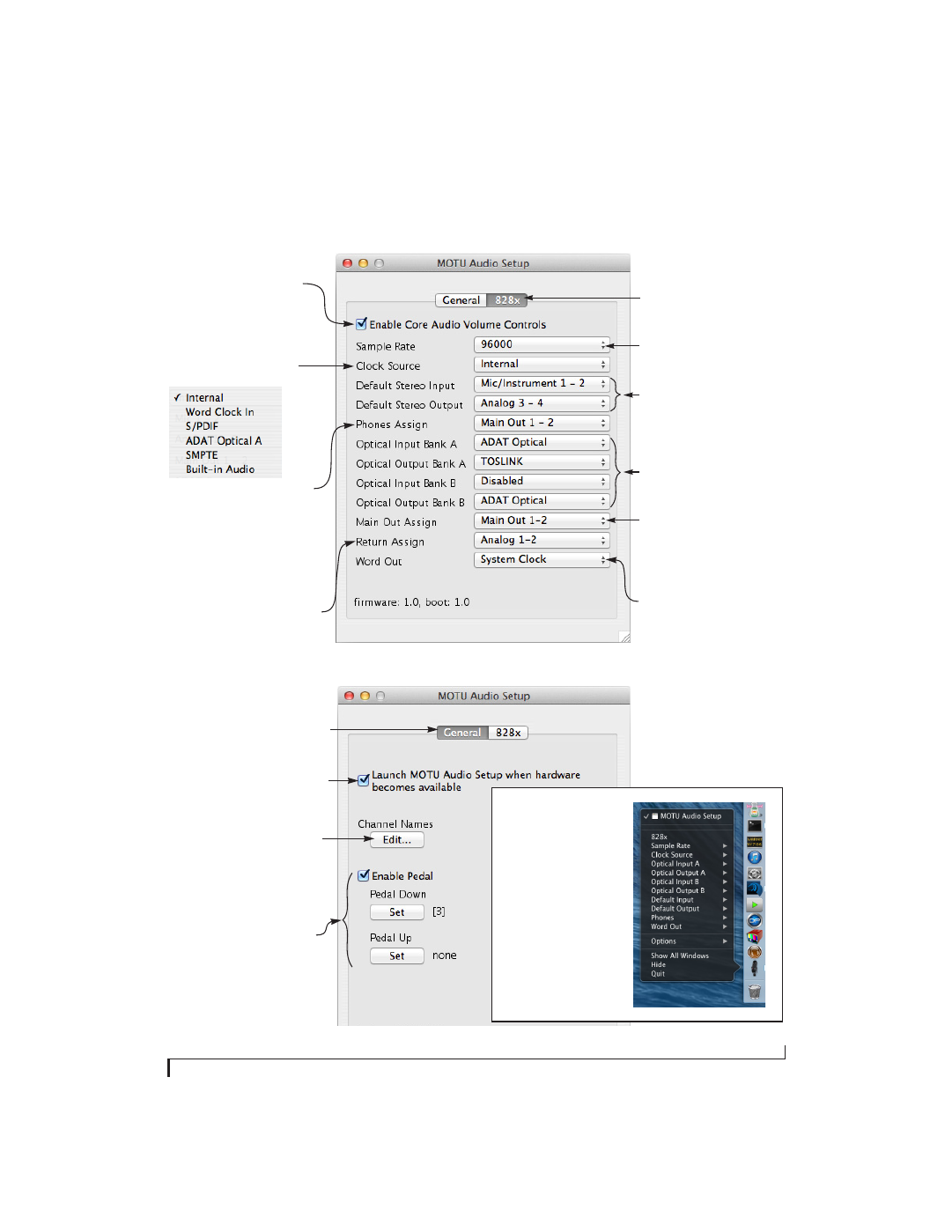Quick reference: motu audio setup, Chapter – MOTU 828x 28x30 Audio Interface with ThunderTechnology User Manual
Page 9

CHAPTER
9
Quick Reference: MOTU Audio Setup
Lets you to use the Mac’s volume
controls to control the output level of
the 828x when it is being used as the
audio output hardware for your Mac.
The 828x driver provides a stereo return
back to the computer. This return feeds the
signal on any 828x output pair directly back
to the computer, where you can record,
process, monitor or otherwise use it. This is a
great way to “bounce” full mixes, complete
with live audio routed through the 828x
only, back into the computer.
Determines the clock source for your
828x. If you’re just using the analog ins
and outs, set this to ‘Internal’. The other
settings are for digital transfers via
S/PDIF or optical ports, or for slaving
the 828x to word clock.
Specifies the stereo input and output
pair when the 828x is chosen for
Mac OS X audio I/O.
Choose the global sample rate for the
system here.
If you are running an 828x interface at a
high sample rate (88.2, 96, 176.4 or 192
kHz), this option appears in the inter-
face tab. It lets you choose a word clock
output rate that either matches the
global sample rate (e.g. 96kHz) or
reduces it to the corresponding 1x rate
(e.g. 48kHz instead of 192 kHz).
This menu lets you choose what you will
hear from the PHONES jack. To mirror the
main outs, choose
Main Out 1-2
, or you can
mirror any other output pair. To hear the
phones as their own independent output,
choose
Phones 1-2
(at 44.1 or 48 kHz. At
higher sample rates, the phones must
mirror any other available output pair.)
Click the tabs to access general MOTU
interface settings or settings specific to
the 828x (or other connected interface).
Check this option if you would like the MOTU
Audio Setup icon to appear in the application
dock as soon as a MOTU interface is detected
(switched on, plugged in, etc.)
Click the General tab to access these settings.
Each optical bank can be configured
independently for ADAT or TOSLink.
Disable them when not in use to
conserve DSP and bus bandwidth.
Choose the output pair you would like
the main outs to mirror, or choose
Main
Outs
to operate them as their own
independent pair.
If you have a foot switch connected to the
828x, these settings let you map the foot
switch to any computer keyboard key for
both the up and down position. For
details about how to set this up, see
“Enable Pedal” on page 44.
This button opens another dialog that lets
you assign your own customized names to
each 828x input and output. For example, if
you have a lead vocal mic plugged into
input 1, you could name it “Lead Vox”. Your
customized names then appear in your host
audio application (if it supports Core Audio
input naming).
In the standard Mac OS X
fashion, MOTU Audio Setup
appears in the dock when
you launch it. If the
Launch
option is checked (as shown
above), the icon appears as
soon as you switch on your
828x interface. If you click
and hold on the dock icon
(instead of clicking it) or
control-click, a menu of
hardware settings appears
as shown to the right. You
can view and configure any
hardware settings from this
menu, without opening the
MOTU Audio Setup window.
